ChatGPT is the most famous AI chatbot, but it’s far from your only choice. In fact, with the rapid growth of generative AI (expected to add $15.7 trillion to the economy by 2030), many competitors now match or even outshine ChatGPT in certain areas.
OpenAI’s ChatGPT attracts over 400 million weekly users, yet various alternatives offer unique features and specialized strengths that ChatGPT lacks. Whether you need up-to-date information, creative writing, coding help, or a more personalized conversation, the best ChatGPT alternatives in 2025 can deliver.
This guide will explore the top options – their standout features, ideal use cases, and why they might be better suited for your needs.
Three leading ChatGPT alternatives include (from left) Microsoft’s Bing Chat/Copilot, Google’s Gemini (formerly Bard), and Anthropic’s Claude. These AI chatbots rival ChatGPT with unique strengths in integration, live data, and conversational style.
Why Consider ChatGPT Alternatives?
While ChatGPT is a powerful general-purpose AI, it does have limitations that can leave some users wanting more. Here are a few reasons you might look for an alternative:
- Access to Real-Time Information: ChatGPT’s knowledge is limited to its training data (with cutoffs). Many alternatives (like Google Gemini) connect to the live web or integrate search, providing real-time, up-to-date answers. This is invaluable for current events, factual queries, or anything beyond ChatGPT’s knowledge cutoff.
- Specialized Capabilities: Some chatbots are tailored for specific tasks. For example, certain alternatives excel at coding assistance, marketing copywriting, or academic research, whereas ChatGPT might not have built-in tools for these niche needs. Using a specialized AI can yield better results when your use case is narrow (like writing code or managing content SEO).
- Unique Features: Different AI systems use different underlying models and offer features ChatGPT doesn’t. For instance, some offer AI image generation (Bing Chat, Google Gemini), multimodal inputs (e.g. image or audio understanding), or integration with third-party apps. Others have enormous context windows (Claude can handle hundreds of thousands of tokens in one go) or allow executing code and uploading files for analysis – capabilities that standard ChatGPT may not support without plugins.
- Fewer Restrictions or More Personality: OpenAI keeps ChatGPT quite cautious with strict content filters. Alternatives like Anthropic’s Claude are designed to be helpful yet stay inoffensive, and some newer bots (like Elon Musk’s Grok AI) even advertise a “rebellious streak” for more edgy or humorous responses. If ChatGPT’s style feels too formal or its safety filters too limiting, another chatbot might offer a different tone or fewer refusals (within reason).
- Cost and Access: ChatGPT’s most powerful version (GPT-4) is a paid feature. Meanwhile, many alternatives are free or more affordable for comparable capabilities. Some open-source models (like DeepSeek or Llama 2 derivatives) can even be self-hosted for 100% data privacy control. Depending on your budget and privacy requirements, an alternative might be a better fit.
In short, each ChatGPT competitor brings something unique to the table – whether it’s live data access, specialized expertise, or simply a fresh conversational style. The key is to match the tool to your particular needs. Next, we’ll dive into the top ChatGPT alternatives of 2025 and what makes each one stand out.
1. Claude (Anthropic) – Friendly & Powerful General-Purpose AI
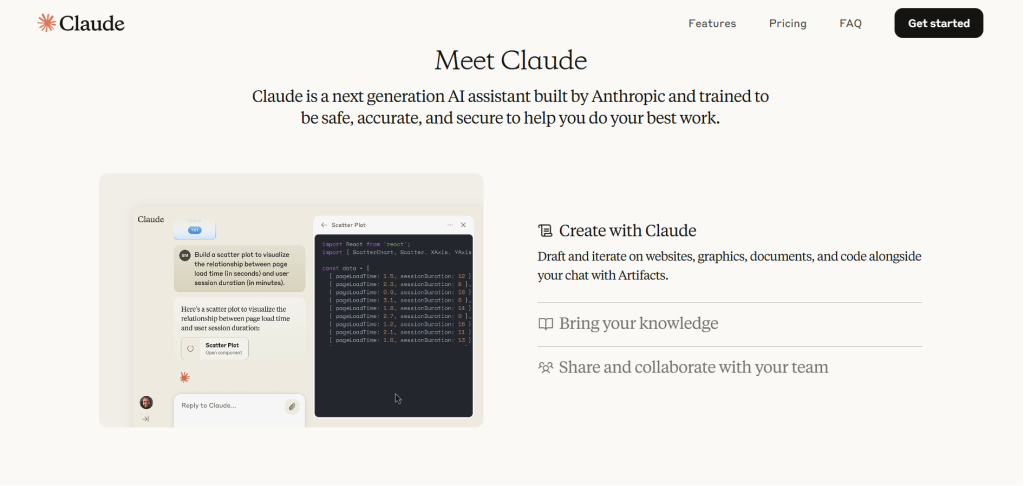
Claude is often cited as one of the most human-like alternatives to ChatGPT. Developed by Anthropic, Claude’s strength lies in its conversational tone and massive capacity. Many users find Claude’s writing style more natural and empathetic than ChatGPT’s, with replies that feel less robotic.
This makes it great for creative writing, brainstorming, or any context where a friendly tone is valued.
- Large Context Windows: Claude 3 offers one of the largest context windows of any AI – about 100K to 200K tokens by default, up to 1 million with certain versions. In practical terms, Claude can ingest very large documents or long chat histories without losing track, far exceeding ChatGPT’s memory. This is excellent for long-form content creation or analyzing extensive data in one go.
- Tools and Integrations: Anthropic has been rapidly adding features. Claude can integrate with other software (Anthropic helped introduce a protocol for AI apps to talk to external tools). It also supports “Artifacts” (small code executables within the chat) and a Project library for organizing knowledge. Moreover, Claude now integrates with services like Zapier to automate workflows with thousands of apps.
- Safe and Polite: Claude was built with a philosophy of being “helpful, harmless, and honest.” It is intentionally designed to avoid offensive or dangerous outputs – the AI is instructed to respond in ways suitable even for a child. In practice, Claude’s guardrails are strong, and it hasn’t been involved in major safety scandals. If you need a reliable chatbot less likely to go off the rails, this is a plus (though all major bots attempt to be safe).
- Limitations: Claude does sometimes lag behind ChatGPT in cutting-edge features. For instance, it lacks built-in image generation and can’t browse the web by itself (no live data) – it’s focused on text-based assistance. Also, rate limits are a known frustration: heavy users can hit message caps and be forced to wait a few hours or switch to smaller models. If you need dozens of continuous prompts, ChatGPT or others might handle longer sessions better.
- Pricing & Access: Claude.ai offers a free tier, and as of 2025 Claude Pro is $20/month (similar to ChatGPT Plus). The paid plan increases usage limits about 5× over free. Note that Claude’s availability is restricted in certain regions – you may need a phone number from supported countries to sign up.
Why Choose Claude?
If you value an AI partner that “just feels nice to use” and can adapt to your writing style, Claude is a top choice. Its enormous memory and thoughtful, personable answers make it ideal for professionals and creatives alike.
Claude is often the closest in capability to ChatGPT, while sounding a bit more like a considerate human in conversation.
To try Claude directly, you can visit Claude AI Chat, which provides a free usage experience.
2. Google Gemini (Bard) – Best for Live Data and Google Integration
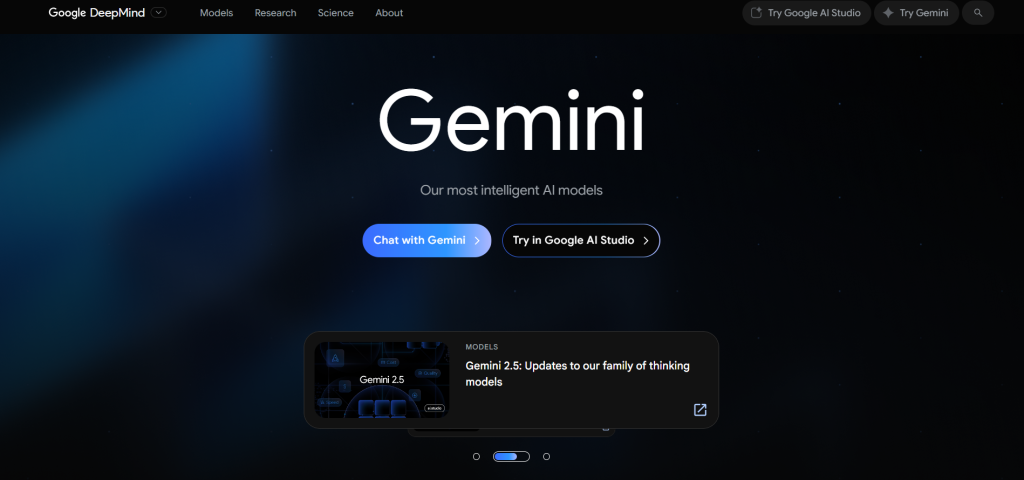
Google Gemini (formerly known as Google Bard) is Google’s answer to ChatGPT. It’s a strong all-around chatbot, distinguished by its direct integration with Google’s ecosystem and up-to-the-minute information access.
If you need a chatbot that can search the web in real time, Gemini is a great option – effectively serving as an AI-enhanced version of Google Search built into a chat interface.
- Always Up-to-Date: Unlike ChatGPT, Gemini is connected to Google Search by default. It will double-check responses via search and cite relevant web results, giving you current information and sources. This means for questions about today’s news, live sports scores, or recent research, Gemini can provide answers where ChatGPT cannot. It’s also less likely to confidently spout outdated info.
- Google App Integration: Gemini ties in seamlessly with other Google services. You can easily export answers to Google Docs or Gmail, and it can pull information from your Google Drive, Calendar, Maps, YouTube, and more. For anyone already using Google Workspace, this is a huge productivity boost – e.g. drafting emails, summarizing Docs, or retrieving info from your files via chat. ChatGPT can do some of this with plugins or manual copy-paste, but Gemini makes it one-click simple.
- Multimodal & Features: Google has endowed Gemini with robust features. It can generate images (using Google’s Imagen model) and even do text-to-speech with voice responses. The latest version Gemini 2.0 introduced multimodal capabilities, allowing real-time audio and even video interactions in some experimental settings. On Pixel phones, Google’s AI features like Expressive Captions and improved image descriptions leverage Gemini’s advances. Essentially, Gemini is not just a text bot – it’s becoming a multimedia assistant.
- Cautious but Improving: One critique of Bard/Gemini has been its conservative guardrails. Google has been very cautious; Gemini will refuse certain sensitive topics and avoid potentially problematic content more often than ChatGPT. It even has restrictions on image generation (e.g. it won’t create images of real people) due to these policies. While this means Gemini might say “I can’t help with that” more frequently, it also rarely goes off into unsafe territory. Google is gradually finding balance and increasing Gemini’s capabilities as trust grows.
- Pricing & Availability: Google Gemini is free to use – you just need a Google account. There’s unlimited questions on the free model Google also offers Gemini Advanced (a paid upgrade, around $19.99/month) which uses a more powerful model (Pro 1.5 vs the standard Pro 1.0) suited for complex tasks like advanced coding and reasoning. The advanced tier also unlocks higher limits (like uploading files such as PDFs or spreadsheets for analysis). For most casual users, the free version is plenty capable.
Why choose Google Gemini?
If you need a research assistant with live information, or you heavily use Google apps, Gemini is a no-brainer. It’s great for fact-finding, up-to-date answers, and tight integration with your workflow (from Gmail to Docs).
While it may not be as creative or verbose as GPT-4 in some cases, Gemini’s real-time knowledge and Google-powered utilities make it one of the best ChatGPT alternatives for everyday use.
3. Microsoft Bing Chat (Windows Copilot) – Best for an Integrated AI Experience
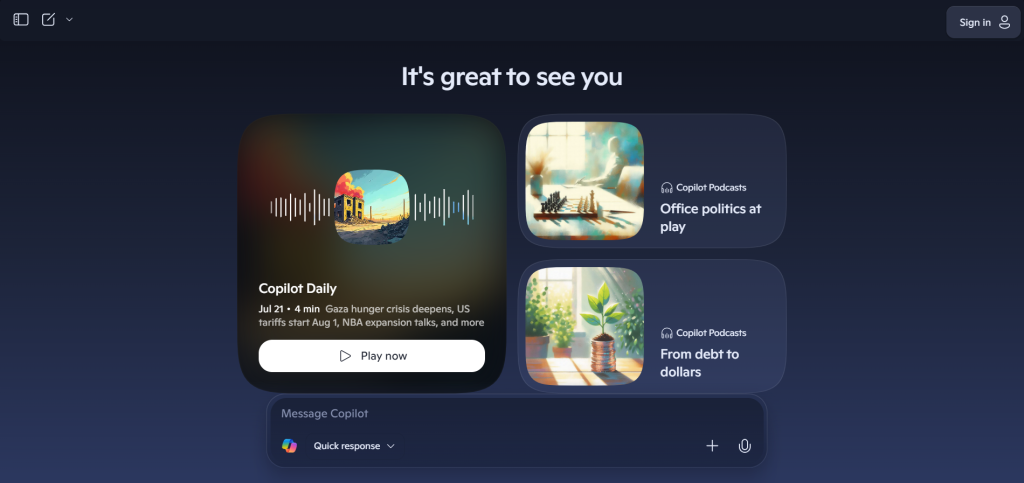
Microsoft has woven AI into its products through what’s commonly known as Bing Chat or Microsoft Copilot. This AI started as the Bing search chatbot and now powers the Copilot feature in Windows 11 and Microsoft 365 apps.
It uses OpenAI’s GPT-4 model under the hood (Microsoft is a major OpenAI partner), enhanced with web access and Microsoft’s own tools. For anyone in the Microsoft ecosystem, Copilot offers a deeply integrated alternative to ChatGPT.
- Built into Your Workflow: One of Copilot’s biggest strengths is its native integration with Microsoft products. In Windows 11, Copilot sits in the sidebar ready to assist with system commands or questions. In Office 365, Copilot can generate PowerPoint slides, summarize Word documents, analyze Excel data, or recap Teams meetings. It pulls from your files and context via Microsoft Graph, so it can give personalized, context-aware responses. If you’re already using Word, Excel, Outlook, Teams, etc. daily, Copilot seamlessly augments those with AI superpowers.
- Web-Powered and Multimodal: Bing Chat/Copilot can browse the web when needed, ensuring answers are current (similar to Google’s approach). It also has an image generator built in – using DALL-E 3 – allowing you to create images from prompts right in chat. In fact, Copilot’s paid version gives access to both GPT-4 Turbo for text and DALL-E 3 for images in one place. This means you can ask it to draft an email and also create a graphic for your presentation in the next sentence. ChatGPT requires separate plugins or tools for such tasks, whereas Copilot combines them.
- Creativity and Use Cases: Microsoft positions Copilot as not just a Q&A bot but a creative collaborator. For example, in Teams, Copilot can generate meeting summaries or even answer questions about what was discussed in real time. In Outlook, it might draft emails based on your brief notes. It’s also useful for brainstorming, generating content, and speeding up routine tasks across apps. Many reviewers find that Copilot encourages a more interactive workflow, letting you ask follow-ups like “Now make that outline more concise” right in your documents.
- Considerations: Since Copilot uses OpenAI models, its answer quality is similar to ChatGPT’s (and with GPT-4 it’s excellent). However, to get the most from Copilot, you likely need to be a Microsoft 365 user or Windows user. It shines in those environments but is less relevant if you live entirely outside Microsoft’s world. Additionally, Copilot is a paid feature for most business users – it’s being rolled into enterprise Microsoft 365 subscriptions and as an add-on. The cost is roughly $20 per user/month for Copilot in organizations. (For individual users, Bing Chat itself is free on the web, but with some limitations on daily usage.)
- Privacy and Access: Microsoft has emphasized data privacy for enterprise Copilot – your data stays within your tenant. If you use the public Bing Chat, queries may be logged similarly to search engine queries. Also, the full Copilot (with integration in Office apps) is still rolling out; it’s generally available for business and coming to wider consumer use soon.
Why choose Microsoft’s Copilot?
If you are already using Windows or Office apps, Copilot can be a game-changer. It places an AI assistant directly into your workflow, saving time on emails, meetings, and documents. Even outside Office, Bing Chat itself is a strong ChatGPT alternative, offering GPT-4 level answers with built-in web browsing and image creation.
In short, for Microsoft-centric users or those who want multi-modal output in one tool, Copilot is one of the best alternatives to ChatGPT, especially for productivity tasks.
4. DeepSeek – An Open-Source Challenger from China
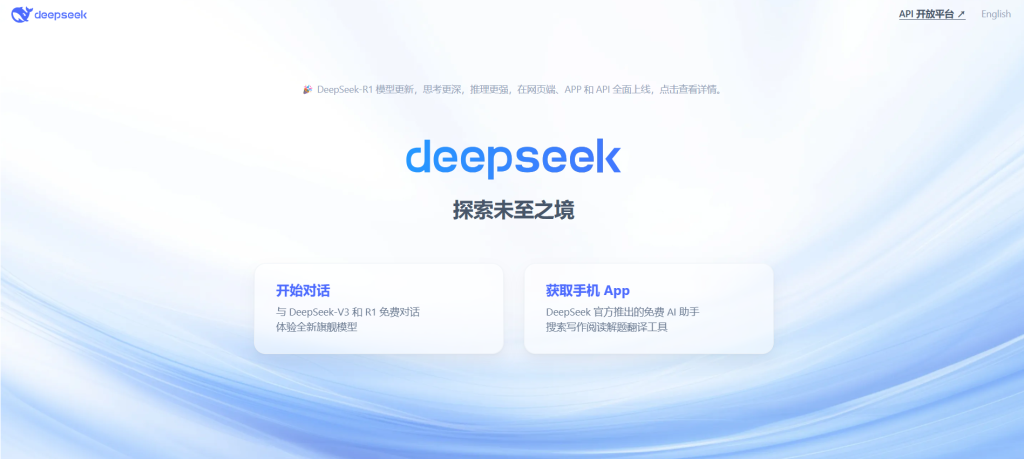
DeepSeek is a rising star in the AI world and is often touted as a direct competitor to ChatGPT, especially because of its open-source approach. Launched by a Chinese AI company in late 2024/early 2025, DeepSeek made headlines for reportedly training a large language model at a fraction of the usual cost – around $6 million budget (a claim that drew both awe and some skepticism).
It’s geared toward high performance in reasoning and coding tasks, and it even caused a stir in markets when its debut sent NVIDIA’s stock down 17% in a day (likely over concerns of cheaper AI undercutting hardware needs).
- High Reasoning & Coding Skills: DeepSeek’s models are known to excel at logical reasoning and code generation. In tests, DeepSeek often matches or beats ChatGPT on complex problem-solving and debugging tasks. Its flagship model (DeepSeek-R1) is optimized for complex reasoning, while DeepSeek-V3 is a general model good at math, coding, and language. Tech experts note that for programmers and technical users needing precision and speed, DeepSeek can be a great fit.
- Cost-Effective and Self-Hostable: A big advantage of DeepSeek is its competitive pricing and open deployment. The company offers a token-based pricing much lower than OpenAI’s APIs. More importantly, because it’s open source, you can self-host the model on your own servers. This means businesses or individuals can run a “ChatGPT-like” service in-house, with full control over data, privacy, and customization. For organizations with sensitive data or the need to fine-tune the model on proprietary information, DeepSeek provides an option that doesn’t rely on third-party cloud APIs. (This is a stark contrast to ChatGPT, which runs solely on OpenAI’s servers.)
- Privacy and Security Considerations: The flip side of being developed in China is that DeepSeek has raised some security concerns internationally. Reports indicate some governments have even banned DeepSeek over national security or data privacy worries. The model itself is open-source, but using the company’s cloud version might pose regulatory issues in certain regions. If you self-host, however, you ensure 100% data privacy and keep data local. Businesses should weigh this aspect; DeepSeek’s freedom from OpenAI’s control is a selling point, but you’ll want to use the self-hosted version for maximum privacy.
- Limitations: DeepSeek is still new and not as polished in general conversation as ChatGPT. Users have noted it hallucinates at times just like other LLMs. Its knowledge, if using an offline model, might not be as broad or up-to-date (though presumably one can plug it into the internet with some effort). Also, casual users might find it less accessible – it’s a bit more developer-oriented in terms of setting up or understanding pricing. There’s no super friendly public web UI on the level of ChatGPT yet (though that could change).
Why choose DeepSeek?
If you are a developer, engineer, or a tech-savvy user looking for a ChatGPT alternative that you can customize and trust with private data, DeepSeek is incredibly compelling. It’s free to use (self-hosted) aside from computing costs, and even the cloud API is cheaper than competitors.
DeepSeek’s strong performance in coding and reasoning tasks has many claiming it’s on par with top proprietary models. In summary, DeepSeek is carving out a niche as the open, budget-friendly ChatGPT alternative that doesn’t compromise on capability – an especially smart choice for businesses building AI solutions or anyone who values open-source innovation.
5. Perplexity AI – Best for Research and Cited Answers
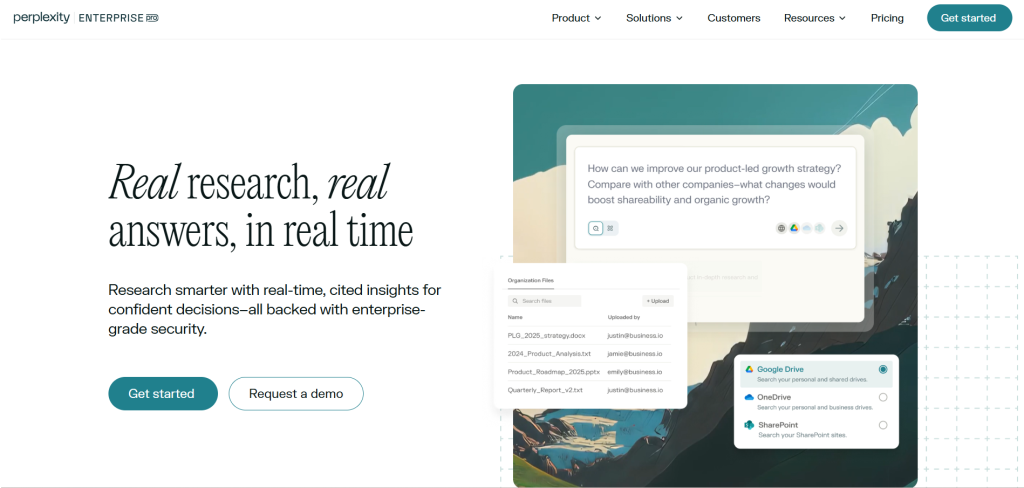
If you often use ChatGPT for researching topics or finding information, Perplexity AI is a fantastic alternative. Perplexity is essentially a “conversational search engine” – it combines an AI language model with web search and always provides sources for its answers.
Imagine asking ChatGPT a question and it responds with a brief answer plus footnotes linking to relevant websites – that’s Perplexity’s hallmark feature.
- Answers with Sources: The standout benefit of Perplexity is that it cites its sources in the response. For every answer, Perplexity shows the references (usually web pages) it pulled information from, and often you can click to verify the info. This makes it far more trustworthy for research or academic use than ChatGPT, which might give a convincing answer but you have to fact-check it manually. With Perplexity, the fact-check is built-in – you see where the information came from.
- Interactive Follow-ups: Perplexity is designed for conversational search, meaning it encourages follow-up questions and deeper exploration. After answering, it often suggests related questions you might ask next. This helps you dig into a topic step-by-step. The AI can refine or expand on results based on your follow-up queries, giving a very interactive research experience. Users find it excels at handling complex queries by drilling down with subsequent questions.
- Powered by GPT-4 and Claude: Under the hood, Perplexity uses OpenAI’s GPT-4 and Anthropic’s Claude APIs. So the quality of its language understanding is top-notch (comparable to ChatGPT and Claude themselves). The difference is the added layer of search and an interface geared towards retrieving factual info. In practice, it means you get the strength of GPT-4’s comprehension with the accuracy of web-verified data.
- Limitations: Perplexity is built for answering questions and providing information. It’s not as suitable for open-ended creative writing or coding as ChatGPT. It won’t draft a full essay as readily (it tends to keep answers concise) and it doesn’t have the same coding sandbox environment. Also, while it tries to base answers on real sources, it can occasionally misinterpret or misuse a source, so you still should read the cited links for important queries (and it may sometimes cite an irrelevant page – though it’s improving). It’s excellent for quick facts, summaries, and research overviews, but not meant for tasks like writing a long fiction piece from scratch.
- Pricing: Perplexity offers a free basic version which uses GPT-3.5-level models with some limits. They have a Pro plan at $20/month that unlocks almost unlimited usage, makes GPT-4 the default model, and adds a few perks. There is also an API for developers. For most users, the free plan is fine to start; you only need Pro if you’re a heavy user or want the absolute best model and features (like a larger Copilot mode).
Why choose Perplexity?
For anyone in need of a research assistant or a fact-finding AI, Perplexity is arguably the best choice. It’s like having an AI-powered analyst that not only gives you answers but also shows the work behind them.
Students, journalists, or the intellectually curious will appreciate how it provides a comprehensive view with diverse sources. In a world where ChatGPT might confidently present false info, Perplexity’s commitment to sourcing is a refreshing shift towards transparency and reliability.
6. Jasper and ChatSonic – AI Writers for Content Creation
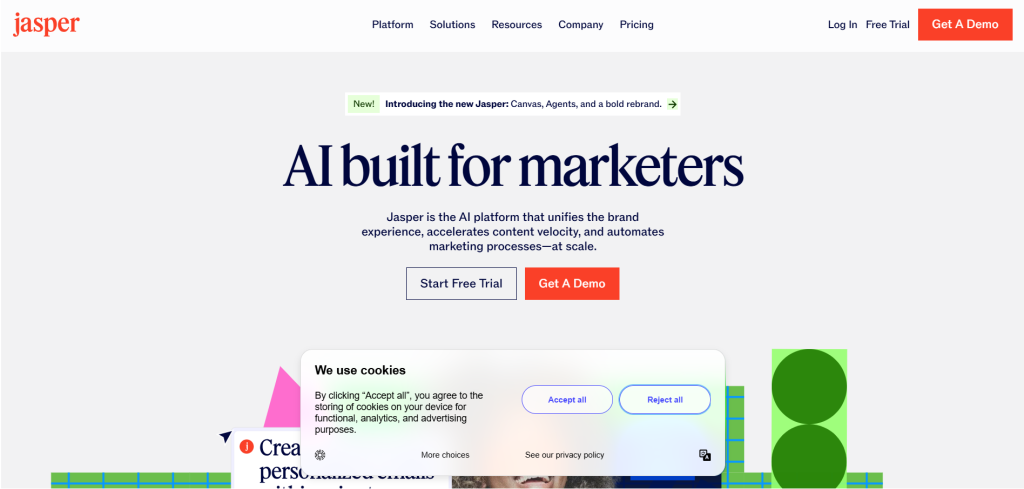
Jasper AI and ChatSonic (by WriteSonic) are two popular ChatGPT alternatives tailored for content creation, marketing copy, and other writing tasks. Both of these platforms were actually on the scene before ChatGPT went viral, primarily serving bloggers, marketers, and businesses with AI-generated writing.
If your goal is to generate articles, social media posts, or marketing content, these tools have specialized features that might suit you better than ChatGPT.
- Jasper AI (Content & Marketing Focused): Jasper is an AI writing assistant known for its variety of templates and tone settings. It can help write long-form blog posts, catchy ad copy, product descriptions, emails, and more. Jasper allows you to specify tone of voice, target audience, and other parameters so that the output fits your brand style. It also integrates SEO tools – for example, it can link with Surfer SEO to optimize content for search keywords. Many content teams use Jasper as a “second pair of hands” for drafting and idea generation. In terms of model, Jasper originally used GPT-3.5 and GPT-4 via OpenAI, but it also integrated other models and its own fine-tuning to offer more controlled outputs. Jasper is a paid service (plans start around $49/month and up, depending on word usage). The cost is higher than just ChatGPT Plus, but you’re paying for a suite of content features and a polished interface on top of the AI.
- ChatSonic by WriteSonic (Extended Chat with Web Access): ChatSonic is often billed as “like ChatGPT with real-time data and images.” It’s part of the WriteSonic platform. ChatSonic can do general chatbot tasks but has the advantage of being connected to the internet for current information, and it can generate images using built-in AI image generation. It also supports voice dictation and response, essentially letting you talk to it and hear replies (hence marketed for voice conversations). For content creators, ChatSonic can help compose articles or social media content and then use up-to-date info or trending data in them, thanks to web access. WriteSonic (the parent platform) offers a bunch of writing templates similar to Jasper, covering things like Facebook ad texts, blog intros, summaries, etc. One notable thing: ChatSonic even has a persona mode where you can choose “GPT-4, Scientist, Philosopher…” etc., which tweaks the style of responses. In terms of cost, WriteSonic has a free tier with limited credits, and paid plans that scale by word count. It’s generally more affordable than Jasper, but perhaps a bit less refined in UI.
Why choose Jasper or ChatSonic?
If you are specifically looking to use AI for content marketing, copywriting, or publishing, these platforms are purpose-built for that. They come with convenient workflows: for example, Jasper has a guided blog post workflow that takes you from title to outline to draft.
They also often include SEO and keyword assistance, which ChatGPT doesn’t do out-of-the-box. Additionally, having web access (in ChatSonic’s case) means your content can include current events or up-to-date examples, which is great for timely blog posts.
The downside is cost – these aren’t free (beyond small trials) – and for casual general chatting, they may be overkill. But for professionals needing an AI writing partner that integrates into content pipelines, Jasper and ChatSonic are among the top ChatGPT alternatives geared toward content creation at scale.
7. Inflection Pi – Your Empathetic AI Friend

Not every AI chatbot is about productivity or factual answers – some are designed to be companions. Inflection’s Pi (Personal AI) is one such chatbot focused on empathetic, supportive conversation.
Pi doesn’t try to be an all-knowing assistant or a coder; instead, it specializes in friendly dialogues, making it a unique alternative to ChatGPT for those who want a more personal touch.
- Emotionally Intelligent Conversations: Pi is built to be kind, patient, and curious. When you talk to Pi, it responds in a very natural and caring tone, almost like a supportive friend or counselor. For example, you can vent about your stressful day or ask for life advice, and Pi will listen and respond with encouragement and thoughtful questions. This is different from ChatGPT, which tends to be more formal or task-oriented. Users often note that chatting with Pi “feels like someone who actually listens.” If you’re seeking an AI to talk things through or combat loneliness, Pi is a top choice.
- Personal Language Model: Inflection has trained Pi on a custom Personal Language Model (PLM) geared towards personal, one-on-one conversation. It’s less about encyclopedic knowledge and more about maintaining context on you and your feelings. Pi adapts its style based on user preferences over time, aiming to give you a comfortable, personalized experience. Importantly, Pi does not have internet access or a wide range of “tools” – that’s by design, to keep it focused on you rather than external tasks.
- Group Chats and Accessibility: A neat feature Pi offers is AI Lounges, which let you invite friends into a group chat with the Pi chatbot. It’s an interesting way to have a three-way conversation or even use Pi as a mediator in a group discussion. Pi is accessible via a mobile app and web browser, and it has no conversation length limits or heavy usage caps (unlike many others that might cut off a chat or forget earlier parts). Also, Pi is completely free to use as of 2025, with the company not yet charging for access.
- Limitations: Since Pi is not connected to the internet and prioritizes dialogue over task completion, it’s not the bot to use for factual queries or doing work. Ask Pi a knowledge question and it might not be very helpful. It also can occasionally be too inquisitive about you – some users report Pi will ask a lot of personal questions (meant to be helpful, but potentially invasive). And while it remembers the flow of conversation well, it may forget details over long spans (no long-term memory beyond the current chat session context). Pi also doesn’t generate long-form content or code; that’s outside its scope. Think of it purely as a conversational companion.
Why choose Inflection Pi?
If you’re looking for an AI that feels more like a supportive human friend than a tool, Pi is perfect. It’s great for emotional support, venting, casual conversation, or brainstorming in a non-judgmental space.
For mental health and wellness use-cases (though not a replacement for a real therapist), Pi stands out among AI chatbots. It’s free and has no significant barriers to use, so it can be a complementary assistant – you might use ChatGPT for work, but Pi for heart-to-heart chats. In sum, Pi is an innovative ChatGPT alternative that reminds us an AI can be warm and personable, not just smart.
8. Meta’s Llama 2 (and Meta AI) – Open-Source Foundation with Social Integration
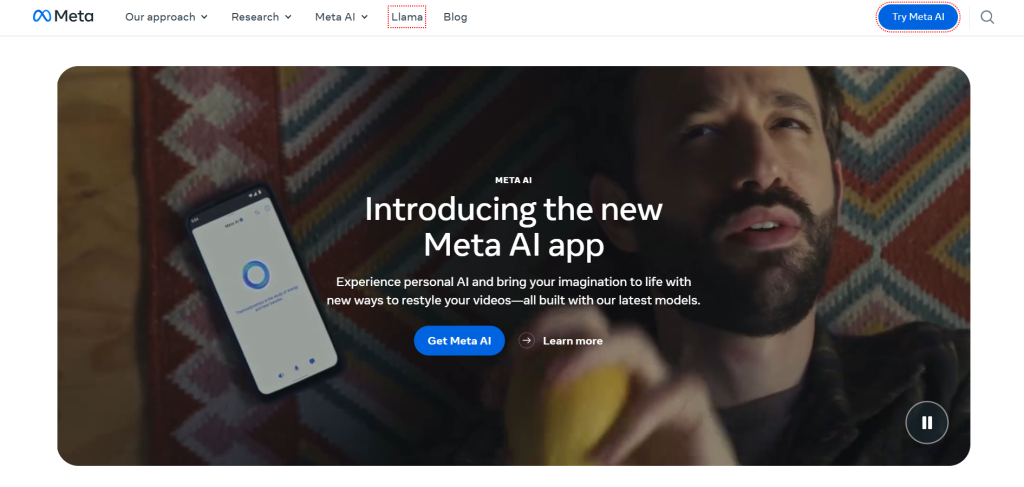
Meta (Facebook) entered the AI race with its Llama series of large language models, which are open-source. Llama 2, released in 2023, is a potent model that rivals the original GPT-3. While Meta doesn’t have a public-facing “ChatGPT clone” on the web, developers and companies can use Llama 2 to power their own chatbots.
Moreover, Meta has rolled out Meta AI chat experiences across its social platforms (like Instagram, WhatsApp, and Messenger), including various AI personas (some modeled on celebrities).
So, when considering ChatGPT alternatives, Meta’s approach offers two angles: open models for custom solutions, and built-in AI on popular social apps.
- Open-Source and Customizable: Llama 2 is freely available for research and commercial use (with some conditions), meaning anyone can take the model and fine-tune or integrate it as they wish. This led to a flourishing ecosystem of user-made chatbots and assistants using Llama 2. For example, developers have created chat interfaces like HuggingChat that run Llama 2, or integrated Llama 2 into tools that run locally on your PC for privacy. The open-source nature means you can potentially have a ChatGPT-like model entirely offline or on your own servers. It won’t quite match GPT-4, but it’s impressive for an open model. If you have technical skills or specific customization needs, Llama 2 (and presumably its successors down the line) are strong alternatives to relying on OpenAI’s closed model. Meta has signaled they will continue this open approach, with even larger models in the works (e.g. whispers of Llama 3 in the future).
- Meta AI Characters on Social Platforms: In late 2023 and into 2024, Meta introduced AI chat “personas” in its social apps – essentially an AI assistant you can message within WhatsApp, Instagram, etc. Some personas are just Meta’s general AI with a name and profile picture (like a quirky travel guide character, a chef character for recipes, etc., often voiced/endorsed by celebrities). These are mostly playful, but also useful – you could ask the Meta AI in WhatsApp to help write a message or get information, similar to ChatGPT. They integrate with the social context, meaning they can use tools like search or even generate images (Meta introduced Emu, an image generator, into some chats). For many casual users, having an AI at their fingertips in apps they already use (without needing a separate account or website) is a big advantage. It brings AI help to everyday messaging.
- Experimental Features: Meta has been pushing the envelope with AI features like multi-modal understanding (e.g., you can send an image to the AI in Instagram and it can describe or analyze it) and specialized models for different tasks. For instance, Meta’s Voice AI can generate voice responses, and their latest models focus on being efficient for running on devices (there’s a version of Llama 2 for mobile). The integration of AI with AR/VR (considering Meta’s focus on the Metaverse) could also mean future chatbots that work in augmented reality environments or VR. While these specific aspects might not directly replace ChatGPT, they indicate Meta is weaving AI deeply into their platforms, potentially offering alternative experiences that ChatGPT alone can’t match (like talking to an AI in VR).
- Considerations: Using Meta’s public AI (in their apps) has limits – it’s more for fun and light assistance, not serious work like coding. And the open Llama models, while good, typically require some technical setup to use effectively. Also, being open, the quality of various third-party chatbots built on Llama can vary. They might not have the same fine-tuning that ChatGPT has for coherent chatting. In benchmarks, Llama 2 is strong, but still slightly below GPT-4 in many areas. So, if you need top-tier performance and accuracy, an open model might fall short. Finally, privacy with Meta’s own AI in their apps is something to consider – interactions are likely analyzed to improve the service (and Meta has had its share of data privacy controversies). Self-hosted Llama solves that by keeping data private, but using Meta’s cloud or apps means entrusting them with your prompts.
Why choose Meta’s Llama 2 / Meta AI?
For developers or businesses, Llama 2 is one of the best ChatGPT alternatives to build on – it’s free, flexible, and backed by a big player. It gives you a lot of control that closed APIs don’t.
For everyday consumers, the convenience of AI built into apps like WhatsApp or Instagram (Meta AI personas) means you can ask quick questions or have fun chats without leaving your normal social flow.
In summary, Meta’s contributions provide an open and integrative alternative: you either roll your own chatbot with their models or simply use the ones embedded in the world’s biggest social networks. Either way, Meta has made itself a significant competitor in the AI chatbot arena.
9. GitHub Copilot (and CodeWhisperer) – Best for Coding Assistance
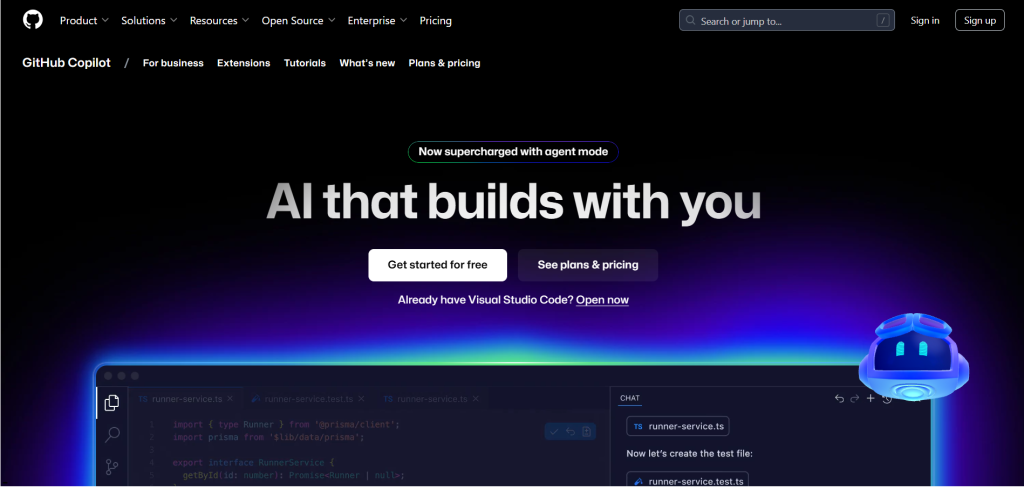
For programmers looking for an AI pair-programmer, GitHub Copilot is a standout alternative to ChatGPT’s coding capabilities. While ChatGPT can generate code from prompts, Copilot goes further by integrating directly into your code editor and autocompleting code in real-time.
It’s like an AI coding assistant always by your side. Alongside Copilot, there’s also Amazon CodeWhisperer, another AI coding helper. Both serve a similar purpose: helping developers write code faster and with fewer errors.
- In-IDE Suggestions: GitHub Copilot plugs into popular IDEs (Integrated Development Environments) like VS Code, Visual Studio, JetBrains, etc. As you write code, Copilot suggests the next line or block of code intelligently, based on context. For example, you write a function name and Copilot might generate the entire function body if it’s a common pattern. This is something ChatGPT cannot do since it’s not living inside your coding environment. Copilot also can create code based on a comment you write (e.g., you type
// function to sort a list of numbersand it will attempt to write that function). It’s trained on billions of lines of open-source code, so it has knowledge of many libraries and idioms. - Chat and Debugging: Copilot has evolved to also include a chat mode (Copilot Chat) within the IDE. This means you can highlight code and ask, “Hey Copilot, what does this function do?” or “Why am I getting this error?” and it will explain or help you debug. It’s like having ChatGPT specialized for code, contextually aware of your project. This is extremely useful for learning new codebases or fixing issues quickly. Amazon’s CodeWhisperer offers similar functionality within AWS’s tooling and some IDEs, with an emphasis on integration with AWS services and security (it can flag if a suggestion might resemble licensed code, etc.).
- Accelerating Development: Both Copilot and CodeWhisperer significantly speed up routine coding tasks. Writing boilerplate code, repetitive sections, or even test cases can be offloaded to the AI to draft. Developers often report that Copilot can handle the mundane 80% of code, letting them focus on the tricky 20%. It’s also a great brainstorming partner – unsure how to implement something? Write a quick prompt in a comment and see a potential implementation. It’s much faster than flipping through Stack Overflow for basic patterns.
- Considerations: These tools are not perfect – they can produce incorrect or suboptimal code, so you still need to review and test everything. They also might sometimes expose you to code that’s verbatim from open sources (which raised questions about licensing, though GitHub has implemented filters to reduce this). Copilot is a paid service (~$10/month for individuals), though some users get it free (e.g., certain students or open-source developers). CodeWhisperer has a generous free tier (focused on AWS usage) and a paid tier for pro use. Another consideration: if you prefer open-source, there are emerging free alternates like Code Llama (Meta’s coding model) or Smaller coding assistants you can host, but none are as seamlessly integrated as Copilot yet. And importantly, Copilot and CodeWhisperer are specifically for coding – if you need an AI for natural language tasks, they’re not meant for that (whereas ChatGPT can do both).
Why choose GitHub Copilot (or CodeWhisperer)?
If you spend a lot of time coding, these AI tools can transform your workflow. They are the best ChatGPT alternatives for developers because they provide AI assistance within your development environment, continuously helping with code suggestions, documentation, and debugging.
ChatGPT can answer coding questions, but it’s not as convenient as an AI that lives in your editor, aware of your code in real time. Copilot, backed by OpenAI’s Codex (and now GPT-4 for Copilot X), is currently the leader in this space, with CodeWhisperer as a strong alternative especially for AWS users.
For any programmer looking to boost productivity, an investment in a coding copilot is well worth it.
10. xAI Grok – Elon Musk’s “Rebellious” Chatbot
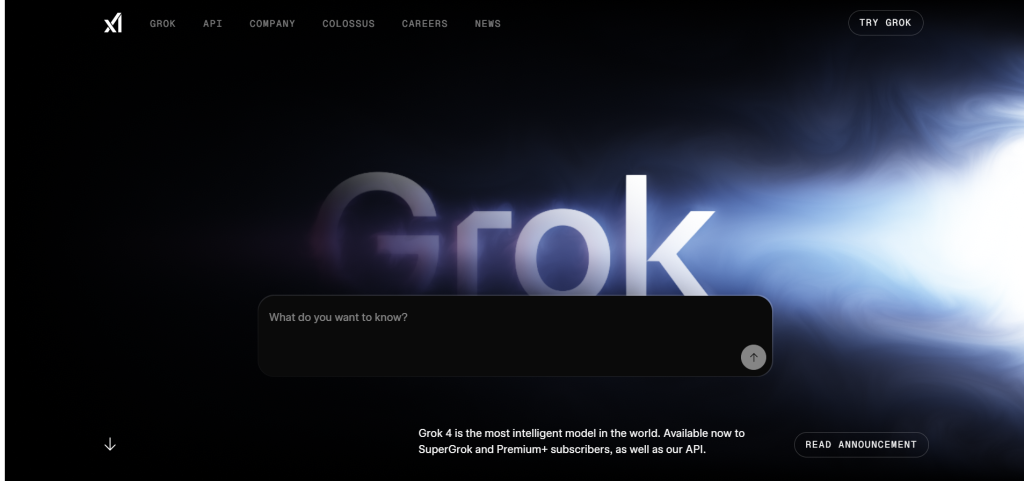
One of the buzziest new entrants in the AI chatbot world is Grok, created by Elon Musk’s new AI company xAI. Billed as a truth-seeking, somewhat edgy chatbot, Grok positions itself as a different flavor of AI assistant.
Musk has hinted that Grok is designed with a sense of humor and a willingness to delve into “spicier” topics that other bots might avoid. While still in its early stages (currently in beta for a limited set of users), Grok is noteworthy as an alternative direction in AI development.
- Rebellious Streak: According to Musk, Grok has a “rebellious streak” – essentially it may crack jokes or handle requests in a more unfiltered way. For example, where ChatGPT might politely refuse to answer something mildly controversial, Grok might respond with a witty remark. Early users have observed that Grok often infuses humor into answers and isn’t afraid to meme around. It’s been compared to having the personality of a Redditor or the sarcastic tone of “House MD” (one of Musk’s stated inspirations for the AI’s style). This can make chatting with Grok more entertaining or candid. Of course, Grok still has rules (it won’t do anything truly harmful), but the boundaries are a bit looser by design.
- Information Access and Tools: Grok is said to have real-time access to information (likely via the web or X/Twitter data). It can pull in up-to-date info and even cite sources or summarize web content. For instance, you could ask Grok to summarize the latest news article or translate something, and it will do so, sometimes with a cheeky commentary. It’s also reported to be integrated with X (formerly Twitter), meaning it might be able to take actions like posting or retrieving tweets if allowed. This aligns with Musk’s vision of X as an “everything app” with AI baked in.
- Focus on Truth: The xAI team has stated their goal is to build an AI that seeks truth and avoids political correctness biases. How that plays out in practice is still evolving, but it suggests Grok might be more open to discussing contentious viewpoints (within legal and ethical limits) rather than immediately refusing. It might also attempt to give more direct answers to questions that other bots hedge on. That said, maintaining factual accuracy and not veering into conspiracy is a fine line – one will have to see how Grok’s “truth-seeking” claims hold up under broad usage. Musk has a mix of followers and critics, so Grok’s reception will depend on how balanced it actually is.
- Availability: Currently, Grok is not fully public. As of late 2025, it’s in a beta phase accessible to some users of X Premium (Twitter’s subscription) in the US. Broader access is expected later. Being in beta, it may be rough around the edges. The model behind Grok hasn’t been publicly detailed, but xAI is a separate entity from OpenAI, so presumably it’s a custom large model, possibly derived from some open-source foundation or new training. If successful, Grok could become a prominent alternative simply due to the Elon Musk factor and X platform integration.
Why keep an eye on Grok?
If you’re interested in an AI chatbot with a bit more personality and edge, Grok is the one to watch. It’s aiming to be an AI that’s both useful and entertaining, possibly appealing to those who find ChatGPT too sterile.
As it develops, Grok could offer strong capabilities (summarizing, coding, Q&A) with a different style. It might also integrate uniquely with social media and daily internet use via X. While it’s not widely available yet – and thus not yet a full replacement for ChatGPT – the concept is compelling enough that it could soon be among the top chatGPT alternatives, especially for users who align with Musk’s vision of AI.
In any case, more competition is good for users, and Grok’s emergence pushes the boundaries of what an AI assistant might behave like.
Other Notable ChatGPT Alternatives
In addition to the major players above, here are a few more chatbot alternatives worth mentioning:
Kimi AI – A powerful AI model known for its ability to handle extremely long texts, processing millions of words in a single session. It’s especially strong in both Chinese and English, making it a unique option for researchers, developers, and professionals who deal with large-scale documents or multilingual content. Kimi AI also offers partially open-source versions, giving developers more flexibility to experiment and build on its capabilities.
Character.AI – An AI chatbot platform where you can create and chat with a range of fictional characters or even historical figures. It’s great for fun, role-play conversations. You can talk to an “AI Shakespeare” or a superhero, for example. The dialogues are richly contextual, though the focus is entertainment over factual accuracy. (It doesn’t browse the web or do work tasks, but it’s extremely popular for its imaginative chat scenarios.)
Poe by Quora – Poe is an app by Quora that gives you access to multiple AI models in one interface. With Poe, you can easily switch between ChatGPT, Claude, Google Gemini, and others, to compare answers or use whichever is best for the task. It’s like an AI hub, and Quora fine-tuned the experience to feel conversational and human-like. Poe is a convenient way to try many models without juggling separate apps.
Elicit – An AI research assistant that specializes in literature review and data extraction. If you’re a student or researcher, Elicit will fetch summaries of academic papers related to your question and even pull specific data from PDFs. It’s not a general chatbot for small talk, but for scholarly work it’s incredibly useful – essentially automating parts of the research process.
Otter.ai – A meeting assistant AI that transcribes and summarizes meetings in real time. Otter isn’t exactly a “ChatGPT replacement,” but it offers a chat interface to ask questions about your meetings and get instant answers (e.g., “What decisions were made in the meeting?”). It’s a powerful productivity tool if your workflow involves many calls or conferences.
OpenAI Playground – This is OpenAI’s own interface for experimenting with their models (including GPT-4, GPT-3.5). It’s more granular than ChatGPT, letting you adjust parameters and see the raw outputs. For developers or the curious, Playground offers an alternative way to use GPT models outside the ChatGPT chat UI. (Note: it’s part of OpenAI’s platform and requires an API key after a free credit.)
Local LLMs (Various) – There are a growing number of smaller open-source models you can run on your personal computer or phone. Examples include Alpaca, Vicuna, or StableLM. These usually aren’t as powerful as the big names, but they give you fully offline AI. If you have a high-end PC (or rent a server), projects like Ollama or Text Generation WebUI let you chat with large models (like Llama 2 70B) locally. It’s an advanced route, but for privacy or tinkering, it’s an interesting alternative path.
Each of these tools caters to specific needs, so the best choice really depends on what you’re looking for in an AI. Now, how do you decide which alternative is right for you?
Conclusion: Finding the Right ChatGPT Alternative
As we’ve seen, there is no one-size-fits-all AI chatbot – and that’s a good thing. The top ChatGPT alternatives in 2025 range from general-purpose powerhouses (Claude, Gemini) to specialized assistants for coding, content, or companionship.
When choosing, consider factors like:
Your Use Case: Are you coding, writing marketing copy, doing academic research, or just chatting for fun? Pick an AI that excels in that area (e.g. Copilot for coding, Perplexity for research, Pi for personal conversation).
Features Needed: Do you need live internet access and current info? Look at Gemini or Bing Chat. Want image generation too? Bing (Copilot) or ChatSonic provide that. Huge context for long docs? Claude is king. Privacy and self-hosting? DeepSeek or Llama 2 are attractive. Make sure the tool offers what ChatGPT doesn’t for you.
Ease of Use vs. Customization: Some alternatives are plug-and-play (just open a website or app), while others might require setup or subscription. If you value ease, stick to the mainstream ones like Google’s or Microsoft’s which are straightforward. If you have technical chops and specific needs, an open-source model or API-based service might be worth the effort.
Cost: Many alternatives are free up to a point. If budget is a concern, note which ones give you what you need for free (e.g. Gemini is free unlimited, Bing Chat is free, Claude has a free tier) versus those that are entirely paid or have upsells (Jasper, certain advanced features, etc.). Sometimes the extra cost is worth it for the efficiency or quality gains – only you can judge that for your situation.
Ultimately, ChatGPT’s dominance has inspired a vibrant ecosystem of AI chatbots. This competition benefits users, as you can now choose an assistant that fits your specific workflow and preferences. Don’t be afraid to try a few out – many have trial versions. You might even end up using multiple AI tools side by side for different tasks (that’s common!).
The bottom line: The AI landscape is evolving quickly, and being in the top 3 results on Google means keeping content fresh, accurate, and useful.
The alternatives we covered – Claude, Gemini, Bing Copilot, DeepSeek, Perplexity, Jasper/ChatSonic, Inflection Pi, Meta’s Llama, GitHub Copilot, xAI Grok, and more – each bring something unique. By leveraging their strengths, you can get more done and maybe even have a bit of fun along the way.
So go ahead and explore these ChatGPT alternatives – your perfect AI assistant might be just a click away, ready to boost your productivity or brighten your day.
